Over the past year or so, Delta Air Lines has been very nicely growing its network of Delta One Lounges, which are exceptional, among the best you’ll find in the US. So far, we’ve seen lounges open in New York (JFK), Los Angeles (LAX), and Boston (BOS).
There’s now an exciting update, as the fourth location in the network will be opening this week, in Seattle (SEA). Let’s take a look at everything we can expect.
In this post:
Details of the new Delta One Lounge Seattle
On Thursday, June 26, 2025, we’re going to see the opening of the new Delta One Lounge at Seattle-Tacoma International Airport.
The new Delta One Lounge Seattle is located in an expansion of Concourse A, adjacent to gate A11. Note that all terminals at the airport are connected airside, so it shouldn’t be an issue to use this lounge regardless of where you depart from.
The Delta One Lounge Seattle will be open daily from 8:30AM until 8PM, covering most long haul departures from the airport, but not necessarily opening to those who may be connecting to another airport to catch a Delta One flight.
The Delta One Lounge Seattle is roughly 10,000 square feet, with seating for a total of 221 guests. So in terms of size, the lounge is around 50% bigger than the Boston lounge, around the same size as the Los Angeles lounge, and roughly one quarter the size of the New York lounge. Keep in mind that Delta’s long haul network out of Seattle isn’t that big, so I can’t imagine the lounge will ever get too busy.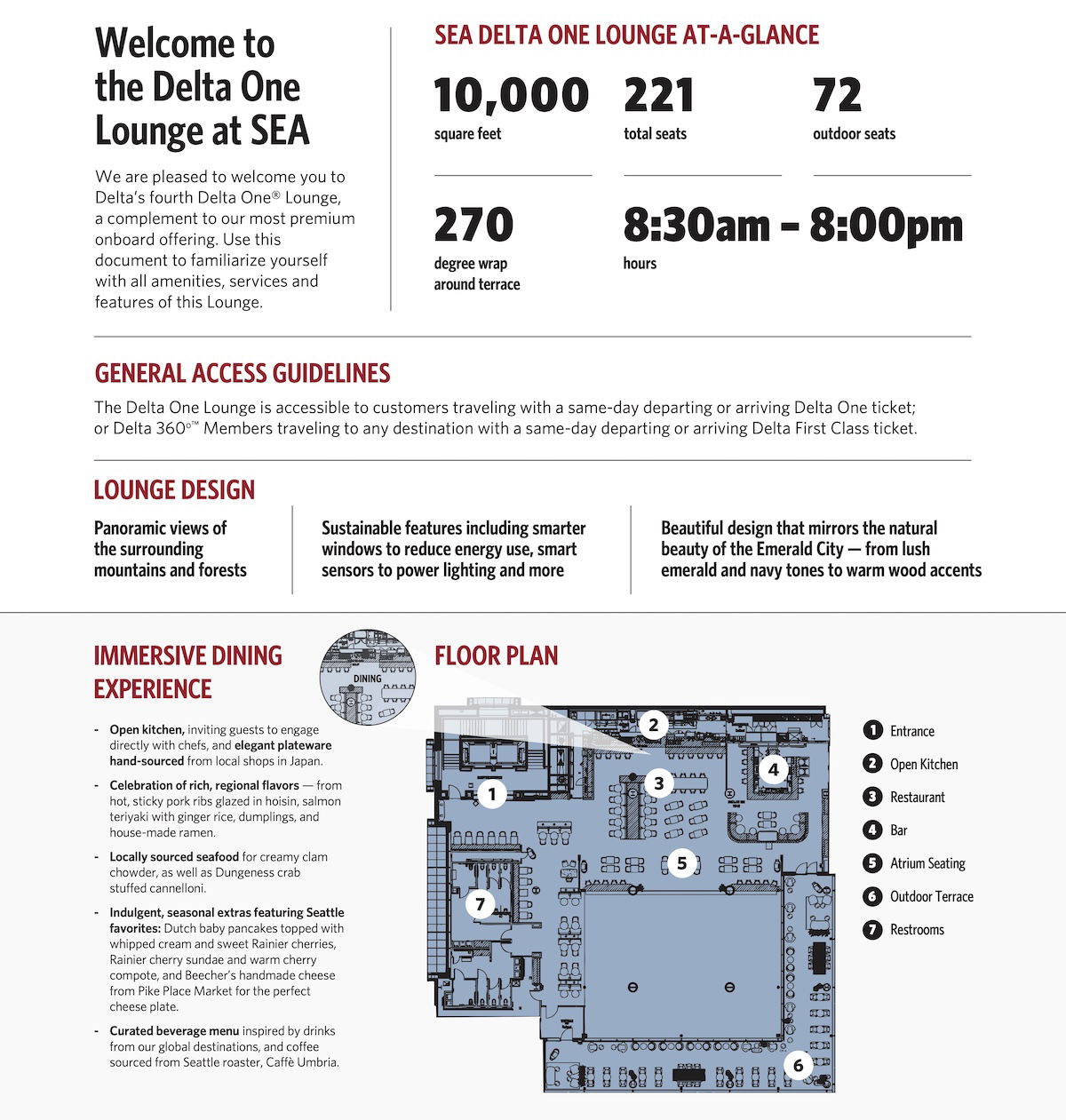
The Delta One Lounge Seattle is located on the fourth level of the terminal, one level above the new Sky Club. Of the 221 seats, 149 seats are located inside, while 72 seats are located on a wraparound terrace, with views of Mt. Rainier.
As it’s described, the lounge’s design pays homage to Seattle’s natural beauty, with stone accents, rich wood paneling, and a palette of emerald, navy, rust, and warm wood tones. Metallic finishes and reflective glass are intended to mimic misty mountain peaks, while curated lighting is supposed to enhance the atmosphere.
As you’d expect, dining is a huge focus for any Delta One Lounge, with a restaurant style dining experience. I’ll talk a bit more about that below. When it comes to special amenities, the Delta One Lounge Seattle is lacking a bit, though. It doesn’t have a spa or wellness area, and for that matter, doesn’t even have showers (though the Sky Club underneath it does have two showers).
Below you can see the pictures that the airline has shared of the new Delta One Lounge Seattle.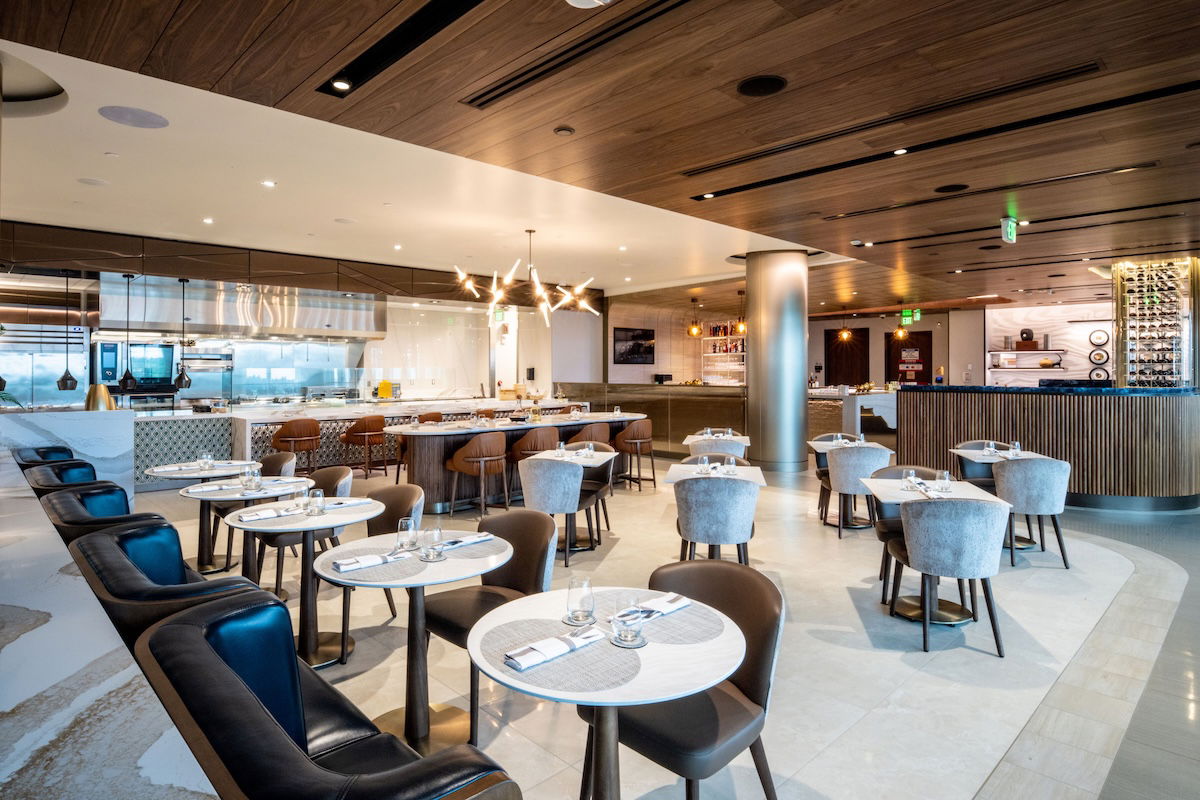

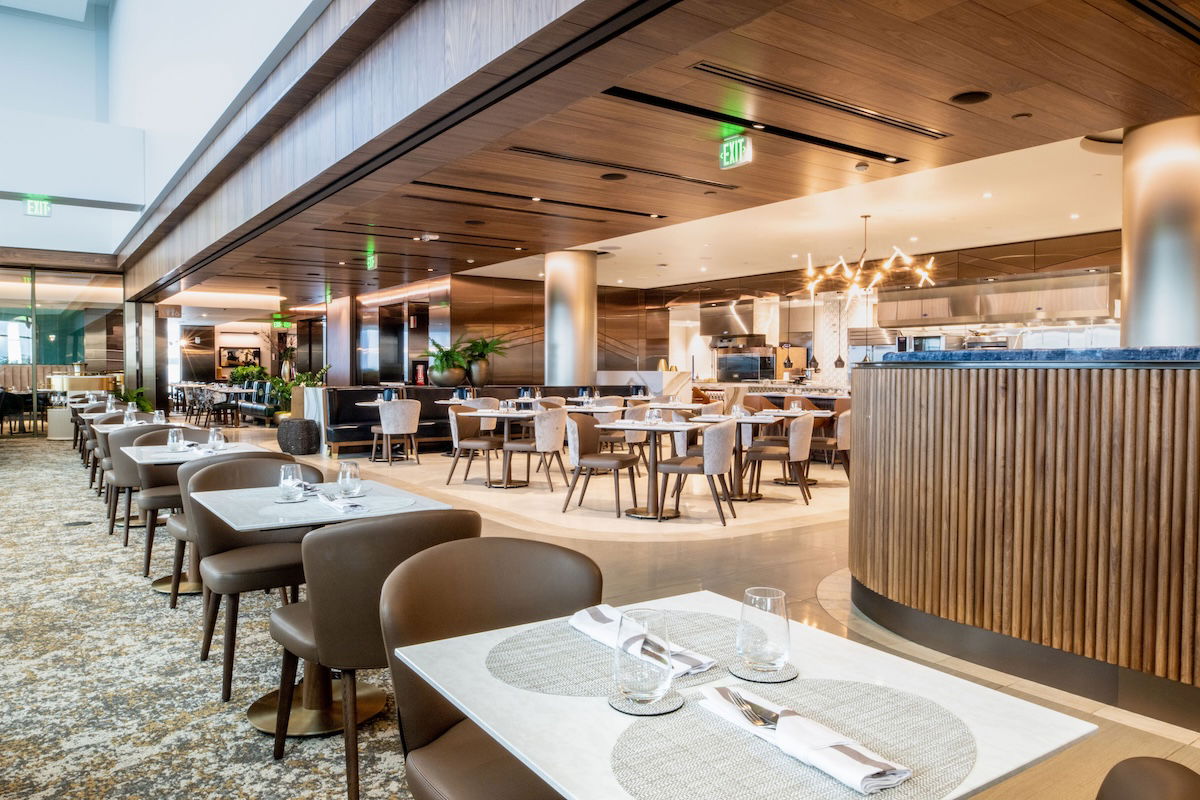
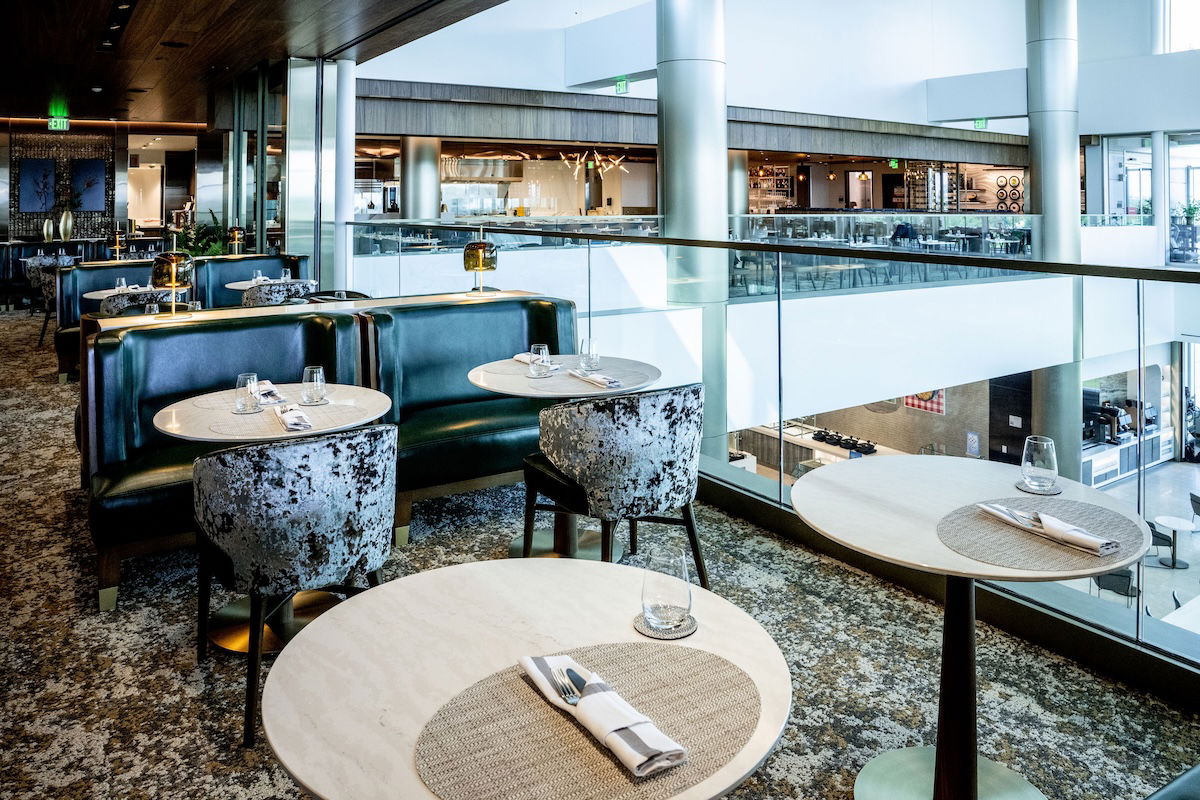

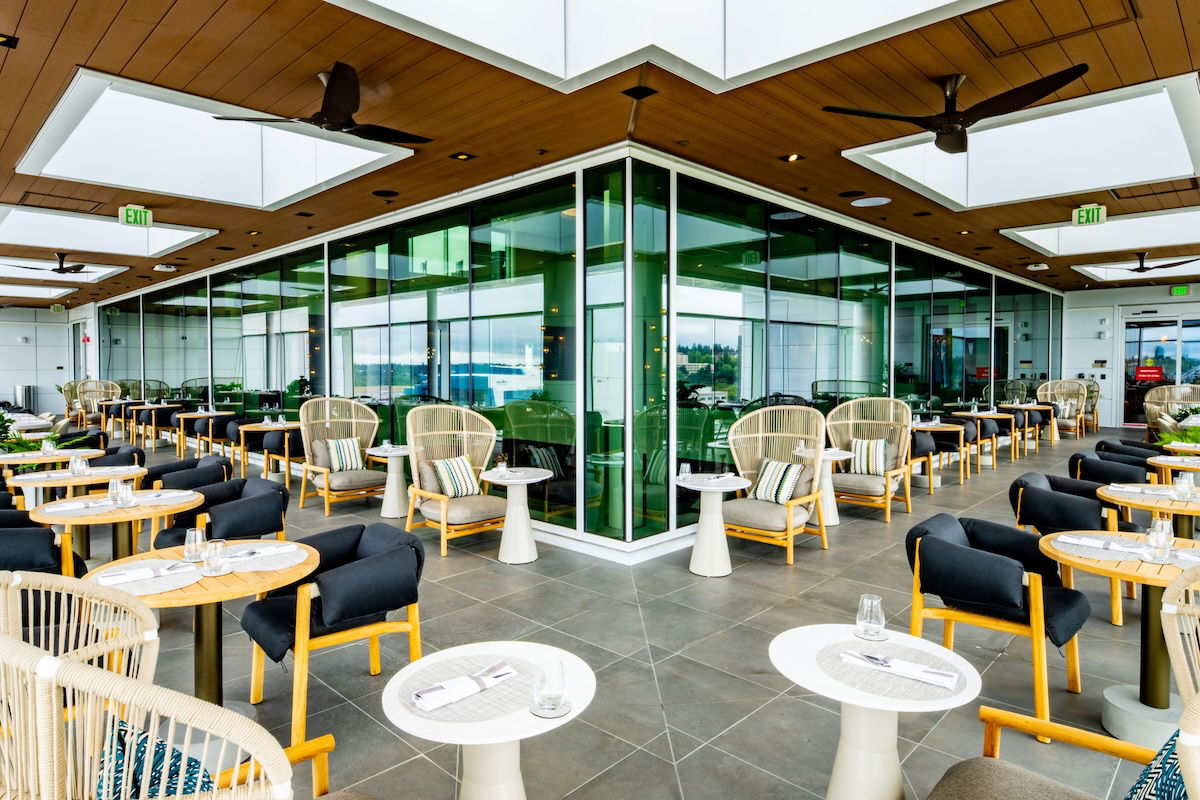
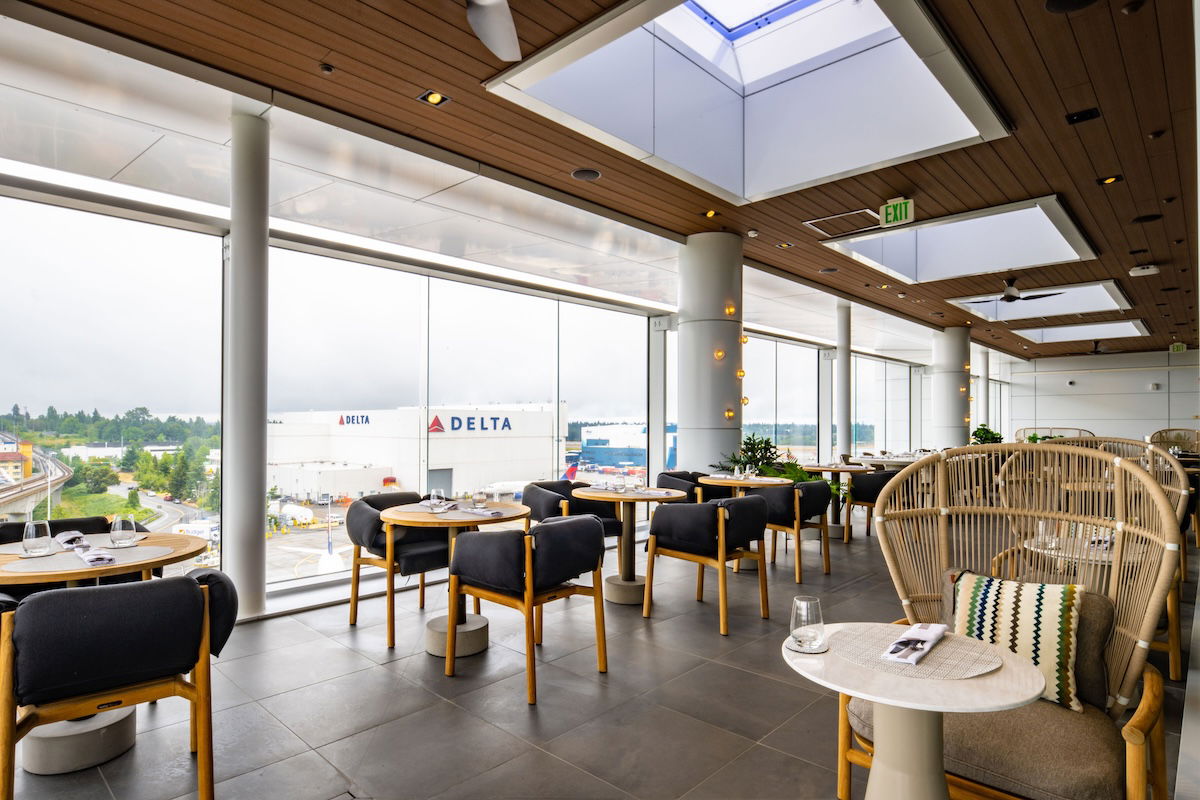
Delta One Lounge Seattle food & drinks
Food and drinks are a huge focus for Delta One Lounges, with a particular focus on partnering with regional businesses.
The Delta One Lounge Seattle is described as offering a Seattle-inspired fine dining experience with an open kitchen. As a standard, the airline serves three course menus, highlighting locally sourced seafood, from dungeness crab cannelloni, to wood-fired teriyaki steelhead, alongside dumplings, ramen, and yellowtail crudo. Desserts include a Rainier cherry sundae, chocolate mousse, and a cheese plate featuring Beecher’s flagship cheese.
Breakfast continues with the Pacific Northwest theme, with fresh pastries, dungeness crab benedict, and dutch baby pancakes topped with Rainier cherry compote. 





Coffee is also sourced from Seattle’s Caffe Umbria. At the bar, guests can enjoy a selection of cocktails inspired by Seattle destinations, premium sake, and a West Coast–focused wine portfolio.

Delta One Lounge Seattle access rules
The Delta One Lounge Seattle has the same access requirements as existing Delta One Lounges. There are essentially three sets of passenger who get access to Delta One Lounges:
- Same day departing or arriving Delta One ticketed passengers (this is the name of Delta’s premium business class experience); it doesn’t matter if you paid cash, redeemed miles, or upgraded
- Delta 360 members departing or arriving on a same day Delta first class ticket
- Same day departing or connecting passengers on flights operated by select Delta partners in first or business class; this includes passengers on Air France, LATAM, KLM, Korean Air, and Virgin Atlantic
As far as guesting policies go, guests aren’t allowed for those eligible for access, with the exception of Delta 360 members. Delta 360 members eligible for access may bring their immediate family (spouse or domestic partner and children under the age of 21), or up to two companions, for an entry fee of $100 or 10,000 Delta SkyMiles per person.
Note that while Delta Sky Club have a three hour access rule (whereby you can only access the lounge within three hours of departure, unless connecting), that doesn’t apply at Delta One Lounges.
Bottom line
The Delta One Lounge Seattle is opening on Thursday, June 26, 2025. This is an exciting development, and marks the fourth lounge in the Delta One network. Delta has really done a phenomenal job with its dedicated business class lounges, and I imagine this lounge won’t be an exception. I look forward to visiting!
What do you make of the new Delta One Lounge Seattle?





It’s an epic design flaw not to have showers.
except there are showers for Delta One customers in the adjacent SkyClub.
It isn't the first lounge operated by an airline that has partially shared facilities.
It makes far more sense for D1 customers to have priority access to a few showers in the Sky Club than the other way around. And a larger number of total showers increases the likelihood of everyone that wants a shower to get one when they want one.
...except there are showers for Delta One customers in the adjacent SkyClub.
It isn't the first lounge operated by an airline that has partially shared facilities.
It makes far more sense for D1 customers to have priority access to a few showers in the Sky Club than the other way around. And a larger number of total showers increases the likelihood of everyone that wants a shower to get one when they want one.
Please do try and think about the pros and cons before you write.
I was just at their launch event. It's truly incredible, they served caviar and dungeness crabs, which will be served as a part of the D1 lounge menu, they're working with a company called The Only Caviar on it.
The only pitfall is there aren't great apron/runway views of the planes. It's facing outwards.
Looks like there's at least view of the metro connection though. I'll never turn down trainspotting over a beer.
Delta could steal candy from a baby and @Tim Dunn would find a way to throw lipstick on that pig.
Barbs aside, the lounge looks nice...though it gives the impression (based on how it's staged) that there are a lot of table and chair set ups but less space dedicated to more comfortable seating for folks not interested in a proper meal.
I'll get to check out the D1 lounge at JFK in October. Forced a routing just so I could see if it's as good as everyone claims.
the real issue is that DL is seeing enormous appeal for their D1 lounges -which you proved with your last sentence.
Delta One lounges upped the business class lounge far beyond what AA or UA did.
The only people that think that DL competes with Polaris are those that can't stomach the reality that DL just leapfrogged AA and UA
You have merit, with Delta having far superior lounges in its flagship product. Care to explain your metrics on how you define D1 Lounges having leapfrogged UA's Polaris Lounges?
"in its flagship product than +(AA).
just read the reviews of multiple bloggers that have said that Delta's D1 lounges are the best in the US.
and given that DL will eventually have D1 lounges in its 4 core hubs - ATL, DTW, MSP and SLC - on top of its 4 coastal hubs, DL could well end up with more D1 lounges with more space than AA or UA.
I have read the reviews. I was asking your metrics of evaluation. It seems you want to dodge the question though. Content creators have opinions and may review products, sometimes its just to generate public interest and to have consumer engagement, sometimes a paid sponsorship, or sometimes just their own personal preference. Just because a content creator alleges a statement, doesn't make it definitive and absolute. There was a time when AA Flagship was a...
I have read the reviews. I was asking your metrics of evaluation. It seems you want to dodge the question though. Content creators have opinions and may review products, sometimes its just to generate public interest and to have consumer engagement, sometimes a paid sponsorship, or sometimes just their own personal preference. Just because a content creator alleges a statement, doesn't make it definitive and absolute. There was a time when AA Flagship was a game change, there was a time when Polaris was the industry leader, so on and so fourth.
And UA already has its flagship lounges in all but one hub.
There is merit when people argue that Delta lost its first moved advantage rolling out its flagship lounges. With AA management in crisis mode, UA and DL can and will strive to make there products better and more competitive.
Quality of lounges, is generally subjective to qualitative characteristics and not easily quantifiable. Example being, if im spending 10k+ on a premium cabin and then when I visit a D1 lounge they want to charge extra for Taiitinger, or Don Julio I think thats straight out disrespectful and cheap. Whilst at Polaris lounges, its all inclusive (with their last offering being Lanson Black Label on my last visit)
are they going to give priority to D1 lounge guests for the Skyclub showers? If I remember correctly, they do something similar at LAX, where 2 showers inside the Skyclub are reserved specifically for Delta One lounge guests
D1 lounges and even the new Sky Club lounges (like the one in ATLTerminal D) are truly a game changer! I’m booked in D1 out of SEA and didn’t know that a D1 lounge was coming, so this is a huge bonus!
One more thing - I love the new private bathrooms that we are seeing in these lounges, especially after arriving on a long haul! Next step - add a seat-bidet, and none...
D1 lounges and even the new Sky Club lounges (like the one in ATLTerminal D) are truly a game changer! I’m booked in D1 out of SEA and didn’t know that a D1 lounge was coming, so this is a huge bonus!
One more thing - I love the new private bathrooms that we are seeing in these lounges, especially after arriving on a long haul! Next step - add a seat-bidet, and none of the top airlines have anything on Delta (well except for using a 2nd door for boarding/unboarding which I think most foreign airlines do.
Delta is doing a great job with their new D1 clubs
Watching and admiring their rivals do it for more than 10 years paid off for them.
I doubt if DL admired anything that AA or UA did with lounges. If anything, it was AA and UA that watched how much better that SkyClubs were than AA and UA's standard lounges.
looks like DL has upped the ante even further.
and let's not forget that lounges are just part of the premium experience. DL is likely going to roll out their second generation Delta One Suite while AA and UA copy each other with the same seat and try to outdo each other in the first row.
I do admire your sad attempts at a comeback. It's fun to watch you flounder.
D1 clubs copied AA and UA. There was a time not long ago when you used to tell everyone DL did not need a business-only club since the Sky Clubs were so great (if you could get in). You've long since left that auto-reply in the dust since Delta proved you wrong -- they did need to copy AA and UA ;)
No, Delta didn’t copy American or united in anything. Delta added the Delta one lounges because it intends to compete in the global aviation arena. The fact that Delta gets a premium to the US international airline revenue means that it is getting a revenue premium even to united.
American gave up competing for premium revenue long time ago. I had said for years and it’s still remains true that if unit can be...
No, Delta didn’t copy American or united in anything. Delta added the Delta one lounges because it intends to compete in the global aviation arena. The fact that Delta gets a premium to the US international airline revenue means that it is getting a revenue premium even to united.
American gave up competing for premium revenue long time ago. I had said for years and it’s still remains true that if unit can be profitable on their international route system, Delta can be even more so.
Happy to hear that business class passengers on Korean Air get access. Will check this lounge out next time I'm doing that flight to ICN.
Any idea if SAS J pax will get access? Since SEA does not have a lot of Sky Team long-haul flights (compared to LAX), I'd hope they would.
@ LOA -- They won't, presumably because they're not part of the SkyTeam transatlantic joint venture.